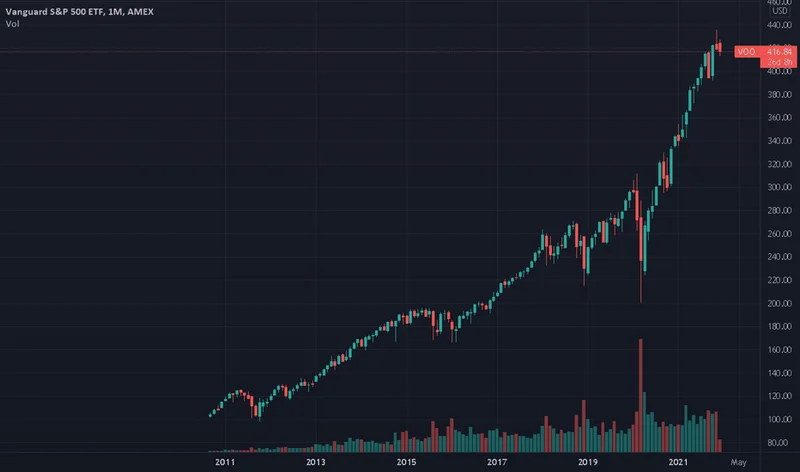The 'VOO and Chill' Philosophy: Navigating the Current Debate and the Future of American Innovation
For decades, the mantra for sensible investing has been a simple, almost Zen-like phrase: "VOO and chill." Buy the Vanguard S&P 500 ETF, which holds a slice of America's 500 largest companies, and just let it ride. It was the financial equivalent of putting your money on a slow, steady, unsinkable barge, chugging its way toward the horizon of retirement. It was safe. It was boring. And it worked.
But I think we’re looking at it all wrong now.
As we stand here in late 2025, with the market at all-time highs and VOO itself up over 18% for the year, the conversation has shifted. I see headlines warning of a bubble, of unsustainable valuations, of cracks in the economy. The old guard sees the barge riding too high in the water and fears it’s about to capsize. But what if it’s not a barge anymore? What if, without us fully realizing it, we’ve collectively turned that simple vessel into a rocket ship?
The S&P 500, and by extension VOO, is no longer just a proxy for the broad "U.S. economy." It has become something far more dynamic, far more concentrated, and infinitely more exciting. It has become our primary, public vehicle for investing in the future itself.
The Index of Innovation
Let’s be clear about what VOO actually is today. It’s a market-cap-weighted fund—which, in simpler terms, means the biggest companies take up the biggest share of the portfolio. And who are the biggest companies right now? They are the architects of our new reality. The Nvidias, the Googles, the Amazons. The titans of artificial intelligence, cloud computing, and global logistics.
So when people fret about the S&P 500's high price-to-earnings ratio of 28.4, they're missing the point. They’re applying 20th-century industrial logic to a 21st-century technological revolution. This isn't like valuing a railroad or a steel mill. This is like trying to value the invention of the printing press in the year 1450. The old metrics simply don't capture the scale of the paradigm shift we're living through. Is a high valuation a sign of a bubble, or is it the market's frantic, forward-looking attempt to price in a future where AI reshapes every single industry on the planet? What does "overvalued" even mean when the underlying assets are creating entirely new markets out of thin air?

I look at the constant hand-wringing over a potential pullback, and I see a failure of imagination. This isn't the dot-com bubble, built on flimsy business plans and dial-up dreams. This is a boom built on tangible, world-altering technology that is already integrated into our lives. This combination of near-zero fees and direct exposure to the bleeding edge of AI and software is a force multiplier for personal wealth—it means the power to invest in world-changing innovation is no longer locked away in Silicon Valley venture capital funds, it's available to anyone with a smartphone and a few dollars.
When I first truly grasped that for an annual fee of just 0.03%—that’s a measly $3 on a $10,000 investment—I could own a piece of the companies building the literal future, I honestly just sat back in my chair, speechless. This is the kind of breakthrough that reminds me why I got into this field in the first place. It’s a quiet, profound democratization of progress.
A Bet on Human Ingenuity
Of course, this transformation of a "safe" index fund into a high-octane bet on technology comes with a new set of responsibilities for us as investors. If you already own a substantial amount of the so-called "Magnificent Seven," adding VOO might not be the diversification you think it is. You're not spreading your risk; you're doubling down on the same thesis. And that’s a crucial distinction.
We have to understand what we're buying. We're not just buying a ticker symbol. We are funding a very specific vision of the future—one dominated by a handful of incredibly powerful technology platforms. This isn't a passive investment anymore; it's an active statement of belief. A belief that innovation will outpace inflation, that software will continue to eat the world, and that human ingenuity is the most powerful economic force there is.
The steady inflow of capital, with investors pouring another $2 billion into VOO in just the last five days (VOO ETF Daily Update, 10/29/2025), tells me I’m not alone in this belief. This isn't blind speculation. It's a calculated, collective wager. We're looking at the challenges ahead—a tricky Fed, geopolitical tensions, economic uncertainty—and we're betting that the sheer creative force of these companies will be more than enough to overcome them.
So, is the old "VOO and chill" strategy dead? Maybe. Or maybe it has simply evolved. It's no longer a sleepy, passive strategy. It's an active, optimistic, and deeply exciting one. It’s a way of saying, "I believe in the builders, the innovators, and the dreamers." How can you not want to be a part of that?
The Future is the New Blue Chip
Forget what you thought you knew. VOO is no longer the market's boring, reliable bedrock. It has become the single most accessible, low-cost, and powerful way for the average person to make a direct investment in the technological frontier. The debate over its valuation isn't about numbers on a spreadsheet; it's a referendum on our collective faith in progress. Buying VOO in 2025 isn't a defensive move. It's an act of profound optimism, a declaration that the greatest returns will come from betting on tomorrow.
Tags: voo stock
Nvidia's $5 Trillion Valuation: What the Numbers Actually Say
Next PostFiserv's Record 44% Stock Collapse: An Analysis of the Guidance Cut and the Market's Reaction
Related Articles
